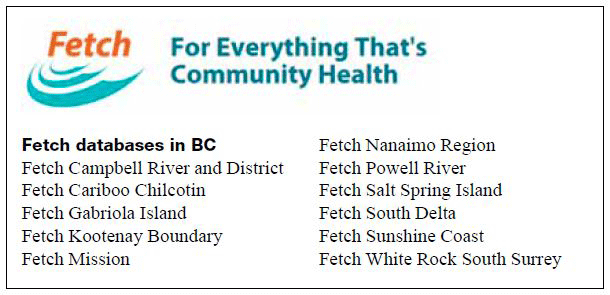Fetch: Community and health resources at your fingertips
Connecting patients with services and resources in the community that can help them better manage their health is an important part of daily practice. In many communities finding these resources can involve a frustrating process of searching the web, sifting through printed documents, and handing out sometimes-outdated brochures from different organizations.
Recognizing that a searchable central database of community resources would improve practice efficiency for their physician members and help improve patient care in the community, the Nanaimo Division of Family Practice created Fetch (for everything that’s community health).
Fetch is a searchable online database that helps physicians and other care providers connect patients with information on health and social resources within the community, including counseling, crisis intervention, employment assistance, and agencies that provide support for various medical conditions. The database is accessible to the public, allowing patients to easily and independently search for information about the services they rely on.
Nanaimo’s Fetch website was launched in 2013. It contains approximately 480 listings in categories such as seniors, First Nations, youth, mental health, substance abuse, emergency food, emergency housing, and shelters. Fetch has been described as an online version of an old-fashioned Rolodex—a valuable tool that provides all the most important information at one’s fingertips.
Community agencies and care providers can create listings on Fetch free of charge. The database is populated with information uploaded by those users, and they remain responsible for updating and maintaining their own content. Fetch listings can incorporate videos, posters, photographs, referral forms, and registration forms that patients can complete and print in advance of their appointments to save time when they arrive. The database can be searched by category or keyword, or by simply browsing an alphabetical list of agencies.
Nanaimo’s Fetch database filled a need that many divisions of family practice around the province had identified through feedback provided at community engagement events—specifically, that health care providers aren’t always aware of all available support services in the community, and that navigating services can be challenging. Once the Nanaimo Division launched Fetch to fill this information gap, other divisions recognized the database’s value and ease of use and used the Nanaimo Division’s template to create their own Fetch databases. (See the box below for the complete list of Fetch databases across BC.)
The initial funding for Nanaimo’s Fetch database was provided through the Nanaimo Division’s infrastructure funds. Other divisions have used A GP for Me funding to launch their Fetch databases based on the Nanaimo template. Fetch databases currently operating around the province will be sustainable on an ongoing basis at very little operational cost to divisions.
To access a complete list of live links to Fetch databases throughout BC, visit www.divisionsbc.ca/provincial/fetch.
—Afsaneh Moradi
Initiatives Lead, Divisions of Family Practice

hidden
This article is the opinion of the GPSC and has not been peer reviewed by the BCMJ Editorial Board.

